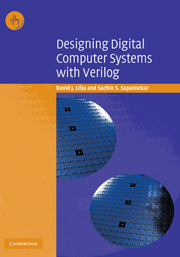
-
Select format
-
- Publisher:
- Cambridge University Press
- Publication date:
- 31 October 2009
- 02 December 2004
- ISBN:
- 9780511607059
- 9780521828666
- 9780521045728
- Dimensions:
- (247 x 174 mm)
- Weight & Pages:
- 0.53kg, 176 Pages
- Dimensions:
- (247 x 174 mm)
- Weight & Pages:
- 0.297kg, 176 Pages
You may already have access via personal or institutional login
Book description
This book serves both as an introduction to computer architecture and as a guide to using a hardware description language (HDL) to design, model and simulate real digital systems. The book starts with an introduction to Verilog - the HDL chosen for the book since it is widely used in industry and straightforward to learn. Next, the instruction set architecture (ISA) for the simple VeSPA (Very Small Processor Architecture) processor is defined - this is a real working device that has been built and tested at the University of Minnesota by the authors. The VeSPA ISA is used throughout the remainder of the book to demonstrate how behavioural and structural models can be developed and intermingled in Verilog. Although Verilog is used throughout, the lessons learned will be equally applicable to other HDLs. Written for senior and graduate students, this book is also an ideal introduction to Verilog for practising engineers.
Contents
Metrics
Altmetric attention score
Full text views
Full text views help Loading metrics...
Loading metrics...
* Views captured on Cambridge Core between #date#. This data will be updated every 24 hours.
Usage data cannot currently be displayed.
Accessibility standard: Unknown
Why this information is here
This section outlines the accessibility features of this content - including support for screen readers, full keyboard navigation and high-contrast display options. This may not be relevant for you.
Accessibility Information
Accessibility compliance for the PDF of this book is currently unknown and may be updated in the future.


